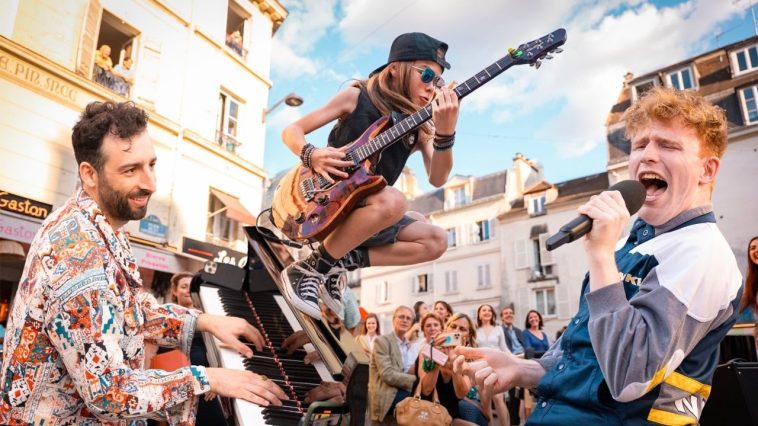The Most INSANE Bohemian Rhapsody Flashmob: When an Anthem of Opera and Rock Took Over the Streets 🤯🎶
Some songs are simply too grand, too sprawling, and too beloved to be confined to a concert stage. Queen’s “Bohemian Rhapsody” is one such masterpiece, and when it’s unleashed in a public space as a surprise flashmob, the result is nothing short of spectacular. The viral video titled “The most INSANE Bohemian Rhapsody Flashmob you will ever see!!” isn’t just hyperbole; it’s a genuine capture of spontaneous, overwhelming collective passion that uses Freddie Mercury’s iconic structure to create an unforgettable public spectacle. This performance is a brilliant case study in how music can instantly dissolve the boundaries between performers and an audience.
Part I: The Quiet Deception and Emotional Unveiling 🤫
The true genius of any flashmob lies in its deceptive simplicity, and this performance of “Bohemian Rhapsody” executes it flawlessly. The video begins with the somber, recognizable opening notes of the ballad section, “Is this the real life? Is this just fantasy?”. A single, strong vocalist emerges, perhaps standing on a small platform or simply blending into the architecture of a public square. The onlookers are initially confused, then intrigued, leaning closer to hear the haunting a cappella start.
As the story of a troubled soul unfolds, the emotional tension builds. The singer delivers the personal tragedy with conviction, moving through the lines about being “just a poor boy, I need no sympathy” and the wind-blown uncertainty of life. The mood shifts dramatically with the shocking central confession: “Mama, just killed a man, put a gun against his head, pulled my trigger, now he’s dead”. At this point, the flashmob element subtly begins to activate, as other singers—who minutes ago were just part of the everyday crowd—start to appear, their voices lending support to the main narrative.
The introduction of the subsequent emotional plea—“Father, I didn’t mean to make you cry” —marks the moment the audience realizes this isn’t just one person singing; it’s a carefully orchestrated event designed to surprise and overwhelm. The collective power of the voices delivering the final word on the ballad section—“nothing really matters”—creates a chilling, beautiful silence before the storm.
Part II: The Operatic Mayhem and Viral Energy 🎭
Just as in the original 1975 track, the flashmob erupts into its most challenging and beloved section: the pseudo-operatic interlude. This is where the term “insane” truly fits the bill. The mood swings violently from reflective sorrow to high-energy, almost chaotic musical theatre.
The chorus of voices multiplies exponentially as dozens of people—some in costume, others still in their street clothes—emerge from different parts of the square. They begin the signature call-and-response vocal layering, often featuring singers popping up from unexpected places, like balconies, walkways, or even behind market stalls. The iconic, rapid-fire sequence of words—“Galileo, Galileo, Galileo Figaro”—is sung with intense, manic energy, creating a dizzying, three-dimensional wall of sound. The sheer complexity of hitting those layered harmonies in a live, open environment is a testament to the planning and dedication of the performers.
The core of this segment is the collective defiance captured in the lyrics, “Bismillah! We will not let you go!”. Delivered by a growing mob, this is less about one man’s struggle and more about a community refusing to give up, with the whole square now buzzing with activity, clapping, and filming the unexpected spectacle. This operatic core provides the necessary lift-off for the track’s massive climax.
Part III: The Rock ‘N’ Roll Climax and Poignant Return 🤘🙏
If the operatic section was organized chaos, the hard rock climax is pure, unadulterated release. As the music transitions into the thundering guitar riff, the movement on stage becomes aggressive and dynamic. Performers start moving, head-banging, and using their full bodies to embody the intensity of the music. This section—often accompanied by a phantom drum kit effect or an amplified solo—is the ultimate collective release.
The group of singers, now easily numbering in the hundreds and backed by the entire cheering crowd, fully immerses itself in the raw energy of the rock track. This is the moment when the audience at the flashmob site transitions from passive observers to active participants, often shouting along with the powerful, wordless vocals and feeling the rhythmic pulse deep in their chest.
Finally, the incredible energy crashes back down to the quiet, philosophical piano outro. The music fades, and a few key singers softly reprise the final, reflective lines: “Nothing really matters, nothing really matters to me”. The camera pans over the faces of the performers and the audience, showing a collective sense of awe and emotional exhaustion.
This “Bohemian Rhapsody” flashmob is a powerful example of why the song endures. It’s an epic journey condensed into a public spectacle, starting from individual sorrow and swelling to a universal roar of passion before settling back into poignant acceptance. It proves that the most “insane” and memorable acts are often those that bring people together through the sheer, unexpected magic of music. 💯




GIPHY App Key not set. Please check settings